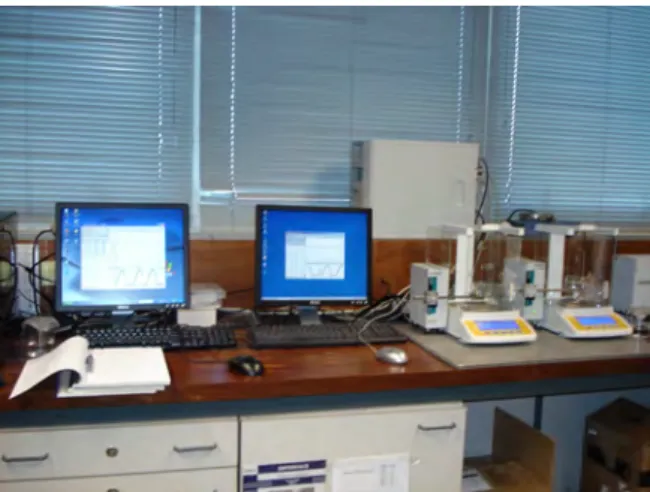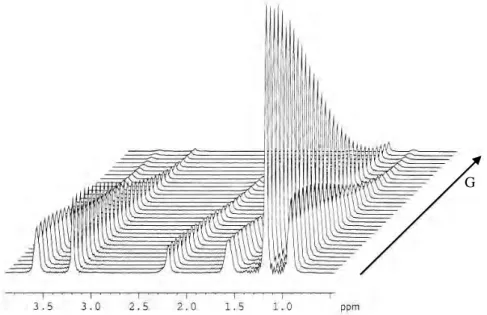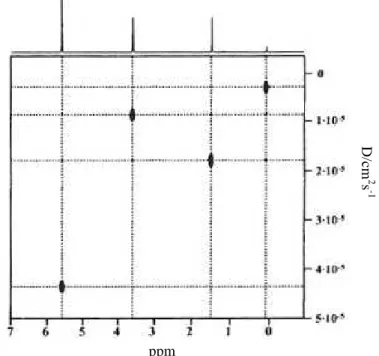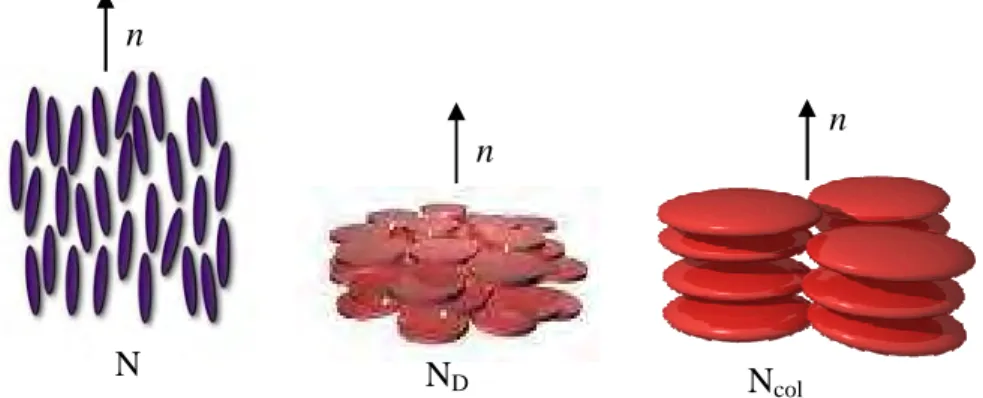Novel Phosphine Oxide Complexes and Inositol Derivatives as Amphitropic Liquid Crystals and
Surfactants
I n a u g u r a l – D i s s e r t a t i o n
zur
Erlangung des Doktorgrades
der Mathematisch-Naturwissenschaftlichen Fakultät der Universität zu Köln
vorgelegt von
Gabriela Cătănoiu
aus Hunedoara (Rumänien)
Köln 2009
Berichterstatter/in: Prof. Dr. H.-G. Schmalz Prof. Dr. C. Stubenrauch
Tag der mündlichen Prüfung: 30. Juni 2009
“Nothing in life is to be feared, it is only to be understood.”
Marie Curie
Familiei mele
The present work was accomplished during the period March 2006 until May 2009 at Institut für Organische Chemie, Universität zu Köln under supervision of Prof. Dr. H.-G. Schmalz and scientific guidance of Dr. D. Blunk.
I am very grateful to Dr. Dirk Blunk for offering me the chance to work under his guidance in this interesting field of amphiphiles and liquid crystals, for all his scientific and non-scientific support, for his patience and kindness towards me in many difficult moments during these three years and, of course, for reading and correcting the present manuscript.
I would like to thank Prof. Dr. H.-G. Schmalz for giving me the opportunity to be a member of his research group, for the excellent work conditions, for his kind advices and helpful discussions.
I am thankful Prof. Dr. Cosima Stubenrauch for making me the honour to be one of the referees for this thesis, for all help and fruitful discussions with the physicochemical part of the present work and for taking care within her research group of measurements which I needed in order to characterize my surfactants. On this way, I would like to thank Dipl. Chem.
Valeria Gärtner and Dr. Sandeep Patil for carrying out the surface tension measurements and phase study for my surfactants, and in particular to Enda Carey for his help, support, assistance, and patience in many situations.
Many thanks to the research group of Prof. Dr. Colin Bain, particularly to Dr. Eric Tyrode and Dr. Scott Shaw for performing the TIR Raman measurements.
I am thankful to my colleague and good friend Montserrat Guiteras Capdevila for helping with the synthesis of one of my surfactants. Muchas gracias, Montse!
I would like to thank the entire NMR department, Mrs. A. Glaese, Mrs. D. Naumann, Mrs. K.
König, Mr. G. Arnold-Hässlich, Dr. K. Etzenbach-Effers, and Dr. Nils Schlörer for their help regarding the NMR measurements. Special thanks to Sebastian Kemper whose knowledge and patience help me to develop the DOSY project.
To Miriam Drayss, M. Neiss and Dr. M. Schäfer I am thankful for carrying out the mass spectrometry measurements, as well as to Mr. C. Schmitz for the elemental analyses, Mr. A.
Adler for help regarding the GC measurements, and Dr. J. Neudörfl for the X-Ray structures.
Furthermore I would like to thank Mrs. Anja Bitners for her friendship and constant help in many administrative problems.
To Wibke Lölsberg and Reinhold Wüstenberg I am thankful for reading and correcting this manuscript, as well as for translation in German of my abstract.
in our lab during these years.
I am thankful to all my colleagues from AK Schmalz/Blunk for their constant support and help, for this friendly and extraordinary atmosphere which made me proud of being a member of this group. Vielen Dank!
Darüber hinaus danke ich allen Mitarbeitern des Instituts für Organische Chemie für die reibungslose und freundliche Zusammenarbeit und der Feinmechanikerwerkstatt unter Leitung von Herrn H. Hartmann für die zahlreichen technischen Hilfestellungen.
I would like to thank the European Community’s Marie Curie Research Training Network
“Self-Organisation under Confinement (SOCON) for financial support.
I am grateful to two special persons who made my life easier in Germany, Mrs. Dörte Blunk who helped me to win the “fight” against German bureaucracy and my German teacher Mrs.
Renate Köllen who helped me understand almost everything around me.
Le mulŃumesc din suflet părinŃilor mei cărora le datorez tot ceea ce sunt astazi şi fără sprijinul cărora nu aş fi putut face faŃa multor momente dificile din aceşti ani. Vă mulŃumesc!
Aş vrea de asemenea să-i mulŃumesc lui Cristian, persoana deosebită din viaŃa mea care mi-a fost alături si m-a ajutat să trec cu bine peste multe momente grele din ultimii trei ani.
Aş dori să-mi exprim recunostinŃa faŃă de Prof. Dr. Ing. Lucian Rusnac care m-a format ca om de ştiinŃă, a crezut in mine si mi-a insuflat dorinŃa de a merge mai departe in viaŃa profesională. Acest doctorat a fost posibil în mare parte şi datorită dumneavoastră Domnule Profesor si vă mulŃumesc pentru tot ceea ce aŃi făcut pentru mine.
There are many persons who helped me during my PhD work and I am thankful to all of them even though the names are not written here.
Carbohydrates are an attractive class of starting materials for organic syntheses since they are highly functionalized and environmentally sound, in this way promoting a sustainable chemistry. A somewhat exotic, but nevertheless readily available family of carbohydrates allowing a fascinating chemistry are inositols (cyclohexane-1,2,3,4,5,6-hexols). myo-Inositol which is the stereoisomer with one axial hydroxyl group, is commercially available at reasonable prices. Inositols have been used previously as hydrophilic head group in amphiphilic liquid crystals, and recently our group involved myo-inositol in syntheses of surface active agents (surfactants). It seems that one unit of myo-inositol is not enough to assure a good aqueous solubility for these compounds. To improve the inositol-based amphiphiles in this respect we extended the inositol head group by a triethylene oxide substructure leading to a new class of inositol surfactants.
This thesis describes the synthetic routes to novel inositol amphiphiles as well as their characterization concerning liquid crystalline, solution and surface properties. The supramolecular properties of the new amphiphiles will be related to those of surfactants with comparable structures.
The second topic presented in this work refers to syntheses of new phosphine oxide metal complexes. Phosphine oxide groups can bind various metal cations such as alkaline, alkaline earth, transition and lanthanide metal ions through ion dipolar interactions. This property allows phosphine oxide-based derivatives to be used in various fields of large economical impact. In addition to the synthesis, the liquid crystalline properties of these complexes are investigated and presented.
Kurzzusammenfassung
Aufgrund ihrer hohen Funktionalisierung und ihrer guten Umweltverträglichkeit sind Kohlen- hydrate ein attraktiver Ausgangsstoff für die organische Synthese und fördern zudem eine nachhaltige Chemie. Eine etwas exotische, aber dennoch leicht zugängliche Familie der Kohlenhydrate, die eine faszinierende Chemie ermöglicht, sind die Inosite (Cyclohexan- 1,2,3,4,5,6-hexole). myo-Inosit, also das Stereoisomer mit einer axialen Hydroxylfunktion, ist zu angemessenen Preisen kommerziell erhältlich. Im Vorfeld wurden Inosite bereits als hydrophile Kopfgruppe von amphiphilen Flüssigkristallen eingesetzt und kürzlich wurden in unserer Arbeitsgruppe oberflächenaktive Verbindungen (engl.: surfactants) auf der Basis von myo-Inosit synthetisiert. Jedoch scheint eine myo-Inosit-Einheit nicht auszureichen, um eine gute Wasserlöslichkeit des oberflächenaktiven Moleküls gewährleisten zu können. Um die Löslichkeit der Inosit-basierten Amphiphile zu verbessern, wurde die Inosit-Kopfgruppe um eine Triethylenoxid-Substruktur erweitert und eine neue Klasse der Inosit-Surfactants geschaffen.
Die vorliegende Dissertation beschreibt sowohl den synthetischen Zugang zu neuen Inosit- Amphiphilen, als auch deren Charakterisierung in Bezug auf ihre Flüssigkristallinität und ihrer lösungs- und oberflächenaktiven Eigenschaften. Ihre supramolekularen Eigenschaften werden in Relation zu Amphiphilen mit vergleichbaren Strukturen gesetzt.
Das zweite Themengebiet dieser Arbeit widmet sich der Synthese von neuen Phosphinoxid- Metall-Komplexen. Phosphinoxid-Funktionen können durch ionische Dipolwechselwirkun- gen an zahlreiche Metall-Kationen binden, darunter Alkali- und Erdalkali-, sowie Übergangs- metall- und auch Lanthanoid-Kationen. Diese Eigenschaft ermöglicht den Einsatz von Phosphinoxid-basierten Verbindungen in diversen Bereichen von hoher ökonomischer Bedeutung. Zusätzlich zu der Synthese werden die flüssigkristallinen Eigenschaften dieser Komplexe untersucht und vorgestellt.
1. INTRODUCTION 1
2. STATE OF KNOWLEDGE 6
2.1. Surfactants 7
2.1.1. General structural features and behaviour of surfactants 7
2.1.2. Nonionic surfactants 9
2.1.3. Critical micelle concentration. Surface tension. Surface tension 12
2.1.4. The Krafft boundary 15
2.1.5. Analytical methods used in surfactants characterization 17 2.1.5.1. Methods for surface and interfacial measurements 17 2.1.5.2. Diffusion ordered spectroscopy (DOSY) 19
2.2. Liquid crystals 28
2.2.1. Thermotropic liquid crystals 28
2.2.2. Lyotropic liquid crystals 32
2.2.3. Analytical methods to characterize liquid crystals 37
3. RESULTS AND DISCUSSION I 41
3.1. Syntheses 41
3.1.1. Protective group strategies with respect to myo-inositol 41 3.1.2. Synthetic strategies towards myo-inositol derivatives 48
3.2. Physical properties 57
3.2.1. Thermotropic mesomorphism 57
3.2.2. Lyotropic mesomorphism 64
3.2.3. Solution properties and surface activity 68 3.2.3.1. Solubility in aqueous solution 68
3.2.3.2. Surface tension 70
3.2.3.3. Adsorption on silica surface studied by Total Internal Reflection Raman spectroscopy (TIR Raman) 74
3.2.3.4. Self-diffusion NMR (DOSY) 78
4. RESULTS AND DISCUSSION II 84
4.1. Phosphine oxides metal complexes 84
4.1.1. Syntheses 85
4.1.2. Physical properties 89
4.1.2.1. Thermotropic mesomorphism 89
6. SUMMARY AND OUTLOOK II 105
7. EXPERIMENTAL PART 107
7.1. General 107
7.2. Studies towards the synthesis of alkyl-oligoethoxylated myo-inositol derivatives 111 7.3. Studies towards the synthesis of phosphine oxide metal complexes 141
7.4. Surface tension measurements 149
7.5. DOSY measurements 151
8. APPENDIX 157
8.1. Overview over all newly synthesized compounds 157
8.2. Abbreviations 160
9. REFERENCES 161
1. INTRODUCTION
The present work is part of a complex project which was funded by the European Community’s Marie Curie Research Training Network “Self-Organisation under Confinement” (SOCON). The SOCON network ran for four years (2005-2008) and it counted thirteen research groups from nine European countries: Ireland (Dublin), Sweden (Stockholm, Lund, Stenungsund), Bulgaria (Sofia), Germany (Cologne, Berlin), Lithuania (Vilnius), Hungary (Budapest), United Kingdom (Oxford, Durham), Denmark (Aarhus), and France (Paris). The focus of the network was on aqueous films, which are either confined between two solid surfaces or by air (foam film) or oil (emulsion film), respectively. Its emphasis was put on complex self-organising systems of environmentally friendly components, such as sugar-based surfactants and polymeric carbohydrate derivatives, but also on the use of traditional surfactants and polymers. The interest in the former class of surfactants and polymers is motivated by the fact that they can be made from renewable materials and that they have favourable properties with respect to applications in various fields. To advance the increased use of more environmentally friendly components, synergistic and antagonistic effects in multicomponent systems have to be understood. In fact, this is one essential element of the joint network research. The wide range of systems which were examined has had in common self-assembly and strong surface activity. The main objective of our research team was to design and synthesize new environmentally friendly compounds from natural building blocks which were further characterized within the network.[1]
One of the models of the multicomponent systems studied in our network dealt with mixtures of the two non-ionic surfactants n-dodecyl-β-D-maltoside (β-C12G2) and n-dodecyl- hexaethylene oxide (C12E6) (Fig. 1.1).
O
OH HO
HO
O O
OH
HO O
C12H25
n-dodecyl- -maltoside ( -C12G2)
OH OH
O
C12H25 6 HO
n-dodecyl-hexaethylene oxide (C12E6)
Fig. 1.1. Molecular structures of the surfactants n-dodecyl-β-D-maltoside (β-C12G2) and n-dodecyl-hexaethylene oxide (C12E6)
The reason for studying mixtures of ethylene oxide (CiEj) and sugar (CnGm) – based surfactants is that they behave quite differently despite of both being non-ionic. To illustrate how differently they behave five examples will be given.
The first example is the adsorption of n-dodecyl-hexaethylene oxide (C12E6) and n-dodecyl-β-
D-maltoside (β-C12G2), respectively, on hydrophilic silica. At first sight, one would not expect a big difference as both surfactants are uncharged, i.e., that the interactions between the silica surface and the non-ionic surfactants cannot differ very much. In fact, quite the opposite was observed. While C12E6 adsorbs strongly on silica, β-C12G2 does not adsorb at all. This is surprising and still not understood.[2,3]
A second prominent difference lays in the temperature-sensitivity of the phase properties:
while the phase properties of aqueous solutions of sugar surfactants are not very temperature- sensitive, those of the corresponding ethylene oxide solutions are. The temperature–
insensitivity of sugar surfactants in aqueous solution results from the strength of the hydrogen bonds between the hydroxyl groups of the sugar unit and water, which prevents any significant dehydration of the head group in the experimentally relevant temperature range. In contrast to the strong hydrogen bonds between water and sugar units, the hydration water of the corresponding ethylene oxide units is attached only via weak dipole–dipole interactions, which leads to an easy dehydration of the head group.[4]
Thirdly, it is not only the strength of hydration but also the hydration number that is completely different. It was found that under similar conditions and for similar head group sizes (as a rule of thumb, a glucose unit is comparable to three to four ethylene oxide units) the hydration of ethylene oxide-based surfactants is one order of magnitude higher than that of sugar-based surfactants.[5]
Fourthly, the flexibility of the head groups is different. While a maltoside unit behaves like a hard rod, the ethylene oxide units behave more like short polymer chains, which, in turn, means that they are much more flexible.[6]
Last but not least, the surface charge density q0 of foam films stabilized by sugar surfactants is pH insensitive down to the so-called isoelectric point, while that of ethylene oxide-based surfactants changes linearly with the pH. It is argued that this difference is a consequence of the fact that an ethylene oxide unit is able to “react” to pH-changes by changing either its hydration degree (easy uptake and release of water) or its conformation (high flexibility).[7]
As both processes are very unlikely in the case of a sugar unit, the uptake of HO− ions is given by the total surfactant concentration rather than by the pH, which results in the observed pH insensitivity.
The mentioned differences automatically lead to the question of how mixtures of CiEj and CnGm surfactants would behave. The answer to this question does not concern only the physical mixtures of the named surfactants[8] but also a “chemical” one, which would be possible by synthesis of a new class of surfactants which contains in the head groups a sugar unit (“half” of the maltoside) together with three units of ethylene oxide (“half” of the hexaethylene oxide) and the dodecyl chain as hydrophobic tail.
The aim of the present work is the synthesis and characterization of this new class of surfactants using as sugar a relatively unknown class of carbohydrates named inositols.
Inositols (cyclohexane-1,2,3,4,5,6-hexols) belong to the group of carbohydrates since they have the same molecular formula C6H12O6 as conventional hexoses but a different constitution. In a way they present the homocyclic carbon analogue of pyranoses like e.g.
glucopyranose, which is why they are sometimes called “C-sugars”. The nine possible stereoisomers of inositol are renewable primary natural products which differ only in their relative stereochemical configuration (Fig. 1.2).
Fig. 1.2. The molecular structures of the inositol stereoisomers. chiro-Inositol occurs as both enantiomers, but here only one of them is represented.
Inositol-based surfactants are expected to have properties which are very similar to those of sugar-based ones. The polyol structure of inositol makes it as suitable as conventional sugars to be used as a hydrophilic head group. Compared to the latter, inositol derivatives possess a higher thermal stability, cannot undergo mutarotation or ring opening reaction, not even at low pH-values, because an anomeric center is lacking. Due to their natural occurrence and similarity to conventional sugars, should be as biodegradable as other carbohydrates.
The past decade witnessed a renaissance in the chemistry and biochemistry of inositols, mainly due to the realization of the role played by phosphorylated myo-inositol (1, Fig. 1.2) derivatives in important biological phenomena such as cellular signal transduction, calcium mobilization, insulin stimulation, exocytosis, cytoskeletal regulation, intracellular trafficking of vesicles, and anchoring of certain proteins to cell membrane.
myo-Inositol (1), the major nutritionally active form of inositol, is a cheap and easily accessible compound as it is industrially extracted from wheat pods. It could be found as well in beans, nuts and fruits. It is vital to many biological processes of the body, participating in a diverse range of activities. It is essential for the growth of rodents, but not for most animals, including humans. Humans can produce myo-inositol endogenously, from glucose, and, even though myo-inositol is sometimes referred to as a vitamin, it is not a vitamin for humans or most animals.
myo-Inositol belongs to the class of cyclitols caring five equatorial and one axial hydroxyl groups. The carbon atom which bears the axial hydroxyl function is always indicated as C2 while the other carbon atoms of the inositol ring are counted from C1 to C6 (Fig. 1.3). myo- Inositol does not present optical activity being a meso compound since it presents a plane of symmetry through the atoms C2 and C5 of the inositol ring.
Fig. 1.3. The molecular structure of myo-inositol
In the last decade, inositols have been used as hydrophilic head group in amphiphilic molecules. To improve the knowledge on the properties of such inositol-based amphiphiles a
number of new regiochemically defined myo-inositol ethers and esters (Fig. 1.4) were previously synthesized and investigated by means of their liquid crystalline mesomorphism as well as their surface activity in aqueous solution.[9-15]
Fig. 1.4. Examples of myo-inositol derivatives previously synthesized
The main problem of the above mentioned derivatives regarding the surface activity was their low solubility in aqueous media. In order to improve the inositol amphiphiles with respect of this propriety, a new class of inositol-based derivatives which contain a triethylene oxide unit in their head group was developed. The present work is going to describe the synthesis and characterization of this new class of amphiphiles.
A second project which will be treated in this thesis involves studies regarding the synthesis and characterization of phosphine oxide metal complexes. Phosphine oxide groups can bind various metal cations such as alkaline, alkaline earth, transition and lanthanide metal ions through ion dipolar interactions. This property allows phosphine oxide-based derivatives to be used in various fields of large economical impacts, such as environmental sciences, medical diagnostics, cell biology, etc. Lipophilic phosphine oxides have been used also as extraction agent for precious metals from aqueous solutions. This property raised the question if it would be possible to induce supramolecular order like e.g. thermotropic or lyotropic liquid crystallinity in phosphine oxides metal complexes amphiphiles. The results of respective investigations will be presented.
2. STATE OF KNOWLEDGE
Surfactants (a contraction of the term surface active agent) are among the most versatile products of the chemical industry, appearing in such diverse products as motor oils for automobiles, pharmaceuticals, detergents, drilling muds used in prospecting for petroleum, and flotation agents used in benefication of ores. The last decades have seen the extension of surfactant applications to such high-technology areas as electronic printing, magnetic recording, biotechnology, micro-electronics, and viral research.[16]
Over the past thirty years liquid crystals (LCs) have become the quintessential molecular electronic materials of our present day era (Fig. 2.1). The ease with which they can be reoriented in electrical fields has led to the development of a plethora of high technology applications, resulting, for example, in the dominance of the flat-panel displays market. Yet, even though the field of displays may appear mature, there is still considerable interest in the development of 3D-diplays, trans-reflective mode displays which utilise the ability of LCDs for daylight viewing, and colour frame sequential devices which in combination with LEDs could lead to brighter displays.[17]
Fig. 2.1. Structural design in, and applications of, liquid crystals. The molecules are shown as molecular materials of defined shape.[17]
2.1. Surfactants
2.1.1. General structural features and behaviour of surfactants
A surface active agent (surfactant) is a substance that, when present at low concentration in a system, has the property of adsorbing onto the surfaces or interfaces of the system and of altering to a marked degree the surface or the interfacial free energies of those surfaces (or interfaces). The term interface indicates a boundary between any two immiscible phases; the term surface denotes an interface where one phase is a gas, usually air.[16]
The surface tension is a measure of the difference in nature of the two phases meeting at the surface. The greater the dissimilarity in their nature, the greater the surface tension between them. A surfactant is a substance which at low concentrations adsorbs at some or all of the interfaces in the system and significantly changes the amount of work required to expand those interfaces. Surfactants usually act to reduce interfacial free energy rather than to increase it, although there are occasions when they are used to increase it.[16]
Surfactants have a characteristic molecular structure consisting of a structural group that has very little attraction for the solvent, known as a lyophobic group, together with a group that has strong attraction for the solvent, called the lyophilic group. This is known as an amphiphilic structure (Fig. 2.2.).
Fig. 2.2. Schematic representation of an amphiphilic structure.
When a molecule with an amphiphilic structure is dissolved in a solvent, the lyophobic group may distort the structure of the solvent, increasing the free energy of the system. When that occurs, the system responds in some fashion in order to minimize the contact between the lyophobic group and the solvent. In case of a surfactant dissolved in aqueous medium, the lyophobic (hydrophobic) group distorts the structure of the water by breaking hydrogen bonds between the water molecules and by structuring the water in the vicinity of the hydrophobic group. As a result of this distortion, some of the surfactant molecules are expelled to the
Lyophilic group Lyophobic group
interfaces of the system, with their hydrophobic groups oriented in such a way that their contact with water molecules is minimized. The surface of the water becomes covered with a single layer of surfactant molecules with their hydrophobic groups oriented predominantly towards the air. Since the air molecules are essentially nonpolar in nature, as are the hydrophobic groups, this decrease in the dissimilarity of the two phases contacting each other at the interface results in a decrease in the surface tension of water. On the other hand, the presence of the lyophilic (hydrophilic) groups prevents the surfactant from being expelled completely from the solvent as a separate phase, since that would require dehydration of the hydrophilic group. The amphiphilic structure of the surfactant therefore causes not only concentration of the surfactant at the surface and reduction of the surface tension of the water, but also orientation of the molecules at the surface with its hydrophilic group in the aqueous phase and its hydrophobic group oriented away from it.[16]
The chemical structures of groups suitable as the lyophobic and lyophilic portions of the surfactant molecule vary with the nature of the solvent and the conditions of use. The hydrophobic group is usually a long-chain hydrocarbon residue, and less often a halogenated or oxygenated hydrocarbon or siloxane chain. The hydrophilic group is an ionic or highly polar group. Depending on the nature of the hydrophilic group, surfactants are classified as:
1. Anionic – the surface active portion of the molecules bears a negative charge, for example RCOO-Na+ (soap), sodium dodecyl sulfate (SDS) (Fig. 2.3).
Fig. 2.3. The molecular structure of sodium dodecyl sulfate (SDS).
2. Cationic – the surface active portion bears a positive charge, for example RNH+3Cl- (salt of a long-chain amine), cetyl trimethylammonium bromide (CTAB) (Fig. 2.4).
Fig. 2.4. The molecular structure of cetyl trimethylammonium bromide (CTAB).
3. Zwitterionic – both positive and negative charges may be present in the surface active portion, for example long-chain amino acid like N,N-dimethyl-N-dodecylglycine (dodecylbetaine, C12BET) (Fig. 2.5).
Fig. 2.5. The molecular structure of N,N-dimethyl-N-dodecylglycine (dodecylbetaine, C12BET).
4. Nonionic – the surface active portion bears no apparent ionic charge, for example oligo(ethylene) oxides or sugar based surfactants (Fig. 2.6).
Fig. 2.6. Molecular structures of the surfactants n-dodecyl-β-D-maltoside (β-C12G2) and n-dodecyl-hexaethylene oxide (C12E6).
2.1.2. Nonionic surfactants
As it was previously mentioned the nonionic surfactants have the surface active portion bearing no apparent ionic charge. There are few advantages and disadvantages of using nonionic surfactants. As advantages could be counted that they are compatible with all other types of surfactants; are generally available as 100% active material free of electrolyte; can be made resistant to hard water, polyvalent metallic cations, electrolyte at high concentrations;
are soluble in water and organic solvents, including hydrocarbons. The disadvantages depend on the class of the nonionic surfactants, some of them are poor foamers (which also can be an advantage sometimes) or have no electrical effects (e.g., no strong adsorption onto charged surfaces). Ethylene oxide derivatives show inverse temperature effect on solubility in water, may become insoluble in water on heating, etc.
The present work is dealing with two main classes of nonionic surfactants: the carbohydrate (sugar)-based and the oligo(ethylene) oxide-based surfactants.
Carbohydrate-based surfactants
Natural surfactants are abundant in both plants and animals in small quantities. The cost of the isolation of these compounds led to the development of the cheaper synthetic surfactants, mainly derived from petroleum. The increasing need for products less toxic and highly biodegradable resulted in numerous studies of new sugar-based surfactants, also considered
“natural surfactants”, as they can occur in nature or may be prepared from natural raw materials.[18] This class of surfactants can be used in several areas, such as food industry (having good functional properties as emulsion stabilization, foaming, etc.), biology (extraction and purification of membranes proteins), molecular recognition in glycobiology or immunology and detergents. Carbohydrate-derived surfactants that are produced and used on an industrial scale are sorbitan esters, sucrose esters, and, which is rather new, fatty acyl glucamides and alkyl polyglucoside.[19]
Sugar-based surfactants possess a carbohydrate hydrophilic part, which can be a mono- or oligosaccharide, and a hydrophobic tail, usually hydrocarbon long-chains. The two moieties can be directly linked via a functional group (ester, ether, hydrazine, amino group, etc.) or separated by a spacer (gemini surfactants).
Alkyl polyglucosides with a worldwide production capacity recently increased to about 60.000 metric tons/year are by far the most important sugar-based surfactant. They are produced by proton-catalyzed acetalation of carbohydrates, preferably of glucose, or by transacetalation of butyl polyglucoside with fatty alcohol.
Strictly speaking, alkyl polyglucosides are not new surfactants but were described as early as 100 years ago by E. Fischer.[20] However, it was not until 1934 that their potential as surface- active agents was appreciated in a patent granted to H. Th. Böhme AG of Chemnitz.[21] They then felt into obscurity for a long time, probably not only because they were difficult to manufacture but also because many other surfactants were already in production. It was not until the first half of the 1980s that this old class of surfactants was unearthed again, against a background of increasing environmental concern.
The intensive use of anomeric alkyl glucosides such as n-octyl β-D-glucoside (β-C8G1) and n- dodecyl β-D-maltoside (β-C12G2) (Fig. 2.7) in biology as effective solubilizing agents for
membrane proteins, among other applications, indicated that these surfactants should be very safe.
O
OH HO
HO
O O
OH
HO O
C12H25
n-dodecyl- -maltoside ( -C12G2)
OH OH
HO O
OH
HO O
C8H25
n-octyl- -glucoside ( -C8G1)
OH
Fig. 2.7. Molecular structures of sugar-based surfactants n-octyl-β-D-glucoside (β-C8G1) and n-dodecyl-β-D-maltoside (β-C12G2)
A huge number of application-related patents in particular are based on the special properties of alkyl polyglucosides, including their compatibility and synergetic effects when they are combined with many other surfactants and ingredients of surfactant-based formulation. This, combined with their low environmental impact, as already mentioned, their amazingly economical cost/performance ratio, and finally the high quality standard already achieved, explains the current interest in carbohydrate-based surfactants. Hence, there is a good chance that sugar-based amphiphiles will play a major role alongside the frequently used traditional surfactants.[22,23]
Polyethylene oxide-based surfactants
The most important class of commercially available nonionic surfactants is the polyethylene oxide alcohols derived from reaction of an alcohol with ethylene oxide. These materials are produced in an excess of billions tons a year and are used in such diverse applications as household and institutional laundry, textile scouring, pulp and paper manufacturing, oil field surfactants, agriculture spray adjuvants, and environmental clean-up. The type of alcohol used as the initiator and the length of the polyethylene oxide chain define the application of these versatile commercial products. A primary driving force for the use of these surfactants is their ready biodegradability and overall environmental acceptability. Nevertheless, current and anticipated environmental pressures ensure their continued replacement of other surfactant materials.[23]
Alcohol ethoxylates, like alcohol sulfates and alcohol ethoxysulfates, can be made from either oleochemical or petrochemical alcohols. Consequently, the linearity of the hydrophobe can
vary from highly linear when the alcohol is derived from oleochemical sources and some petrochemical sources to highly branched from other petrochemical sources. Often a blend of several carbon chain length alcohols is used to produce commercial products.
2.1.3. Critical micelle concentration. Surface tension. Surface concentration.
Micelle formation is the property of surfactant that may be as fundamental, and certainly is as important, as their property of being adsorbed at interfaces and consists in ability of surface active solutes of forming colloidal-sized clusters in solution. Micelle formation or micellization is an important phenomenon not only because a number of important interfacial phenomena, such as detergency and solubilization, depend on the existence of the micelles in solution, but also because it affects other interfacial phenomena, such as surface or interfacial tension reduction, that do not directly involve micelles. Micelles have become a subject of great interest to the organic chemist and the biochemist – to the former because of their unusual catalysis of organic reactions and to the latter because of their similarity to the biological membranes and globular proteins.
The shape of the micelle produced in aqueous media is of importance in determining various properties of the surfactant solution, such as viscosity, its capacity to solubilize water- insoluble material, and its cloud point.
At the present time, the major types of micelles appear to be:
a) relatively small, spherical structures (aggregation number < 100);
b) elongated cylindrical, rod like micelles with hemispherical ends;
c) large, flat lamellar micelles (dislike extended oblate spheroids);
d) vesicles – more or less spherical structures consisting of bilayer lamellar micelles arranged in one or more concentric spheres.
The proportion of molecules present at the surface or as micelles in the bulk of the liquid depends on the concentration of the amphiphile. At low concentrations surfactants will favour arrangement on the surface. As the surface becomes crowded with surfactant more molecules will arrange into micelles. At a specific concentration the surface becomes completely loaded with surfactant and any further additions must arrange as micelles. This concentration is called the critical micelle concentration (cmc). It follows that measurement of surface tension may be used to determine the cmc. A graph of surface tension versus log of concentration of surfactant added will appear as follows (Fig. 2.8):
Fig. 2.8. Schematic drawing of the concentration dependence of the surface tension.
In this graph one can identify three phases:
1
2
3
1) At very low concentrations of surfactant only a slight change in surface tension is detected;
2) Additional surfactant decreases the surface tension;
3) Surface becomes fully loaded, no further change in surface tension.
As shown above, the technique to determine the cmc by measurement of surface tension σ is simple and straightforward. A graph of surface tension versus log concentration is produced.
The cmc is found as the point at which two lines intersect: the baseline of minimal surface tension and the slope where surface tension shows linear decline (plateau).
There are different theoretical models to describe surface tension σ versus log concentration curves. The most common is the model derived by Langmuir and Szyszkowski.[24,25] The Langmuir – Szyszkowski equation is given by equation (2.1):
+ Γ
−
= ∞
c RTln 1 a σ0
σ (2.1)
where σ is the surface tension of the surfactant solution, σ0 is the surface tension of the solvent, Γ∞ is the maximum surface concentration (saturation monolayer coverage), R is the gas constant, T is the temperature, c is the surfactant concentration, and a is the concentration at which a surface concentration of Γ∞/2 is reached. The equation (2.1) is only valid if there are no interactions between the adsorbed molecules.
In the present work another model is used to describe the surface tension curves, namely the Frumkin model.This model takes into account the attractive interactions between molecules adsorbed at the interface. The equation for the Frumkin model is given by equation (2.2):
2
0 ln 1 '
Γ + Γ
Γ
− Γ Γ
+
=
∞
∞
∞RT a
σ
σ (2.2)
with a’ being the interaction parameter. According to this model the surface tension increases with increasing interaction between absorbed surfactant molecules because the mobility of the molecules decreases.[26]
The tendency to adsorb at the water/air interface increases with increasing hydrophobic chain length in a homologous series, which means that the concentration needed for some particular adsorption value decreases with increasing chain length. For a homologous series the shape of the curve itself stays the same. The adsorption rises with increasing concentration until the cmc when the adsorption value reaches a plateau. The interface concentration reaches its maximum Γ∞ at this point. Further surfactant addition has no effect on the adsorption density
and thus on the surface tension. The minimal required space per surfactant molecule can be calculated from the Γ∞ value and is given by the equation (2.3):
min
1 A NA
=
Γ∞ (2.3)
where NA is the Avogadro constant (NA = 6.023 1023 mol-1) and Amin is the minimal surface area per surfactant molecule.
2.1.4. The Krafft boundary
Most systems possess many qualitatively different solubility boundaries at different temperatures. If we talk about solubility boundary, we tend to think about the liquid phases.
But it is important to remember that other phases may possess solubility boundaries as well.
In other words, two liquids, a liquid and a solid or two solids can coexist in a miscibility gap.[27]
The amphiphilic nature of surfactants allows them to form numerous aggregates in aqueous solutions, which, in turn, may result in numerous different phases, depending on the temperature and the composition. Many surfactants are high soluble in liquid water at high temperatures, but separate from the solution as a crystal phase at lower temperatures. The crystal solubility boundary in aqueous surfactant solutions is called the “Krafft boundary” in honour of its discoverer, Prof. Friedrich Krafft (1852-1923). This boundary has a distinctive shape (Fig. 2.9), and terminates at its upper temperature limit at a eutectic discontinuity. This eutectic is called the Krafft discontinuity or Krafft eutectic. The saturating phase at the solubility boundary at temperatures above the Krafft eutectic is usually (but not always) a liquid crystalline phase.
Fig. 2.9. The general form of the Krafft boundary.[28]
Far below the temperature of the Krafft eutectic the solubility of surfactants is small and the crystal solubility boundary is steep, which signifies that a low temperature coefficient of solubility exists. As the temperature is increased a turnover or “knee” develops, and just above this knee a plateau exists. Along the plateau the slope is small and the temperatures coefficient of solubility is very large. The plateau terminates at the Krafft eutectic, at which the crystal solubility boundary intersects that solubility boundary which exists at higher temperatures. The liquid phase at the intersection of these two solubility boundaries is also the most dilute of the three phases that may coexist at the Krafft eutectic. [28]
In a series of studies aiming to explain the shape of the Krafft boundary it was noted that the composition of the boundary at the knee is similar to the critical micelle concentration (cmc) of surfactants. The dependence of the cmc on temperature, at values above the Krafft boundary, has been determined for a number of soluble alkyl sulfate salt surfactants. The cmc versus temperature function has been extrapolated to its intersection with the independently determined Krafft boundary, and the point of intersection (which clearly falls within the knee) has been termed the Krafft point (Fig. 2.9).
The presence of a knee and a plateau in a crystal solubility boundary is not unique to aqueous surfactant systems, and the existence of these features does not require that micellar phenomena exist within the liquid phase. They are found in the crystal solubility boundary in the phase diagrams of all solute-solvent systems that are useful for purification by recrystallization, and micellization within the liquid phase does not exist in the vast majority of these systems. [28]
Temperature
Percent surfactant
2.1.5. Few analytical methods used in surfactants characterization 2.1.5.1. Methods for surface and interfacial measurements
Reduction of the surface and interfacial tension is one of the most commonly measured properties of surfactants in solution. Since it depends directly on the replacement of molecules of solvent at the interface by molecules of surfactant, and therefore on the surface (or interfacial) excess concentration of the surfactant, it is also one of the most fundamental of interfacial phenomena.[16]
Measurements of the surface or interfacial tension of liquid systems is accomplished readily by a number of methods. Some of them are based on dynamic principles and are thus suitable to measure the tension as a function of time. Others are static or quasi-static methods and yield dynamic tensions as well, but also allow reaching the equilibrium state of a liquid interface and hence are able to measure the equilibrium tension. While dynamic methods require theories for data interpretation that take the dynamic character into consideration, the data from static methods can be understood more easily. To overcome this problem Joos developed a theory which reduces the data from dynamic methods to a so-called effective lifetime of the interface, which is equivalent to the time needed at a static interface to reach the same adsorption state.[29] In this way measurement results from all experimental techniques can be directly compared.
The following Table 2.1 gives an overview of methods dedicated to surface tension measurements of liquid interfaces.
Table 2.1. Methods for measuring surface and interfacial tension of liquid interfaces[30]
Method Suitability for liquid/liquid Suitability for liquid/gas
Capillary Rise Technique possible good
Capillary Wave Damping possible possible
Drop Volume Method good good
Growing Drops and Bubbles good good
Inclined Plate Method bad good
Maximum Bubble Pressure Method possible good
Oscillating jet bad good
Pendent Drop Method good good
Plate Tensiometry bad good
Ring Tensiometry bad good
Sessile Drop Method possible possible
Spinning Drop Method good possible
Static Drop Method good good
In the present work the method used to measure the surface tension is the ring tensiometry after Du Noüy, therefore this method is going to be described more detailed.
Ring tensiometry after du Noüy
The ring tensiometry is the most frequently used technique to measure the surface tension of pure liquids and solutions. As mentioned above the ring tensiometry is difficult to apply to liquid/liquid interfaces, as it is connected with complicated wetting problems. The same is true for the plate tensiometry, so that complementary techniques are required for these interfaces.
In the du Noüy ring method, a thin wire ring is inserted below the interface and held horizontal. Then the ring is pulled up through the interface. The force F measured by a balance goes through a maximum Fmax.[31] In a first approximation the surface tension σ is given by equation (2.4):
R F σ π
4
= max (2.4)
where R is the radius of the ring. Note that for equation (2.4) to hold, the radius of the wire must be much smaller than the radius of the ring and that the solution must wet the wire completely. For this reason a clean platinum wire is usually used. For precise measurements, a correction factor f to the ideal case is required:
Rf F σ π
4
= max (2.5)
This correction factor f takes in account the ring geometry and the liquid density ρ and usually is included into the software of most tensiometers but can be also determined by using the tables. For this thesis, the values for measured surface tension were calculated using the Harkins and Jordan correction factors which are expressed as a function of R/r and R3/V, where r is the radius of the wire and V is the volume of the liquid raised above the free surface.
Surface tension measurements for the present work were carried out using a STA-1 tensiometer from Sinterface (Fig. 2.10), which has an accuracy of 0.1 mN m-1.
Fig. 2.10. (a) STA-1 tensiometer, (b) Sartorius balance, (c) measurement vessel, (d) platinum ring, (e) Plexiglas box.
The equipment consists of three parts: a computer to control the measurements, a Sartorius balance and the tensiometer itself (Fig. 2.11). Solutions were placed into a glass vessel, and the measurements are done in a closed Plexiglas box to prevent contamination and to maintain the humidified environment.
Fig. 2.11. The surface tension measurements equipment: the computer, the STA-1 tensiometer and the Sartorius balance.
2.1.5.2. Diffusion ordered spectroscopy (DOSY)
Studies of surfactants have constituted a cornerstone in physical chemistry ever since the pioneering work of McBain[32] at the beginning of the twentieth century, and many different experimental methods as well as the theoretical modelling have been employed. Of the experimental methods, nuclear magnetic resonance (NMR) has come to play a pivotal role during the last decades. It is fair to say that no other spectroscopic methods can compete with
a
b c d e
NMR regarding versatility, and the technique offers many unique capabilities. It is essentially a nonperturbing method in that it utilises nuclei already present in the investigated molecules or inserted into them by means of isotope labelling as probes.[33]
There are many different aspects of NMR studies of surfactant systems, covering both liquid solution phases and liquid crystalline phases. This subchapter will summarise one of the NMR diffusion methods for surfactants in solution, respectively diffusion ordered spectroscopy (DOSY) using pulsed field-gradient (PFG) NMR spectroscopy.
Over the last decade, pulsed field-gradient (PFG) NMR spectroscopy has become the method of choice for measuring diffusion in solution in both chemical and biological systems. In principle, the diffusion coefficient of a certain molecular species under given conditions (for example, solvent and temperature) depends on its “effective” molecular weight, size and shape. Therefore, it is evident that diffusion can be used to map intermolecular interactions that play an important role in both chemistry and biology in solution and which lie at the heart of molecular recognition, a process which is essential to supramolecular and combinatorial chemistry.[34]
The fact that molecular diffusion can be measured by NMR methods was realised in the early days of NMR spectroscopy.[35] The most practical pulse sequence for measuring diffusion coefficients was introduced by Stejskal and Tanner in 1965[36] long before the advent of 2D NMR spectroscopy which is currently routinely used by chemists worldwide. The last decade has witnessed an explosion in the utilization of gradients in all areas of NMR spectroscopy, ranging from coherence selection in high-resolution NMR spectroscopy to magnetic resonance imaging (MRI). Being a totally non-invasive technique it is particularly suited to studying molecular dynamics and translational diffusion.
Translational diffusion is one of the most important modes of the molecular transport. Self- diffusion is the random translational motion of ensembles of particles (molecules or ions) as a consequence of their thermal energy. In case of self-diffusion, no (net) force acts on the molecular particles and, consequently, no net displacement is observed. It is well known that diffusion is closely related to molecular size, as seen from the Einstein-Smoluchowski equation:
f N
RT f
T D k
A
b =
= (2.6)
where D is the self-diffusion coefficient, kb is the Boltzmann constant, T is the absolute temperature, f is the so-called hydrodynamic frictional coefficient, NA is Avogadro’s number,
and R is the gas constant. For a sphere in a continuous medium of viscosity η, f is given by the Stokes equation:
f = 6πηRH (2.7)
where RH is the hydrodynamic radius. Combining equations (2.6) and (2.7) leads to the familiar Stokes-Einstein equation:
H b
R T D k
πη
=6 (2.8)
The Stokes-Einstein equation (2.8) indicates that, by measuring the self-diffusion coefficient of a given molecular species under controlled conditions, one may obtain information on its effective size or weight and, therefore, on the specific interactions of the species with its molecular environment. Thus the diffusion coefficients are sensitive to structural properties of the observed molecular species such as weight, size and shape, as well as binding phenomena, aggregation and molecular interactions.[34]
Different mobility rates or diffusion coefficients may also be used as the basis for the separation of the spectra of mixtures of compounds in solution, this procedure being referred to as diffusion ordered spectroscopy or DOSY. The application of NMR diffusion measurements to the separation of small-molecule mixtures in this way is a relative newcomer to high-resolution NMR and is a developing area that is sure to find increasing use in the research laboratory.
All modern NMR-based diffusion measurements rely on the application of pulsed field gradients to map the physical location of a molecule in solution and have recently been made possible on conventional high-resolution NMR spectrometers through the provision of actively shielded PFG probe heads. Molecular diffusion is then characterized along the direction of the applied field gradient, which is typically along the z-axis of conventional gradient probeheads. The basic scheme for the characterization of diffusion is the pulsed field gradient spin-echo (Fig. 2.12).
Fig. 2.12. The pulsed field gradient spin-echo sequence (Gz – gradient chanel, τ – evolution time, ∆ – diffusion time, δ – gradient length).[37]
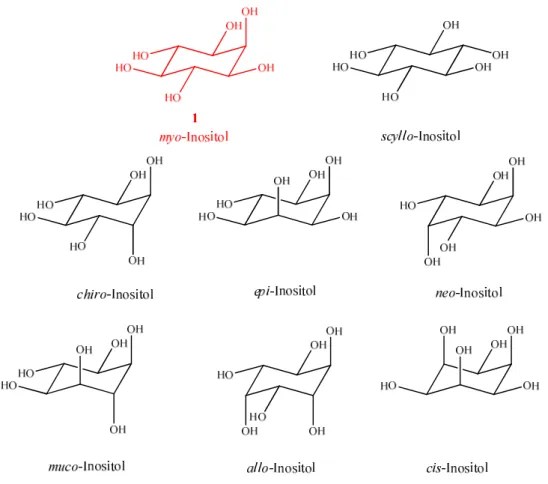
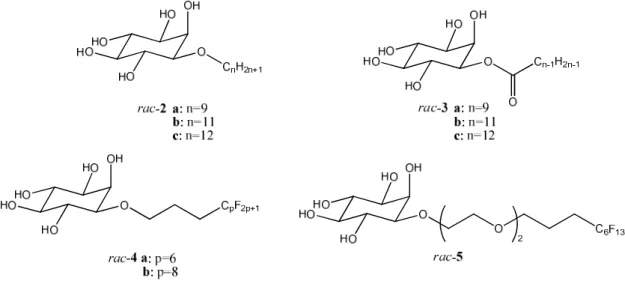
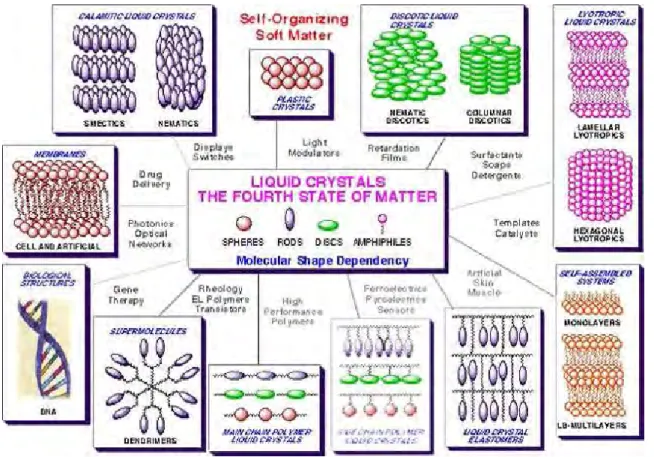
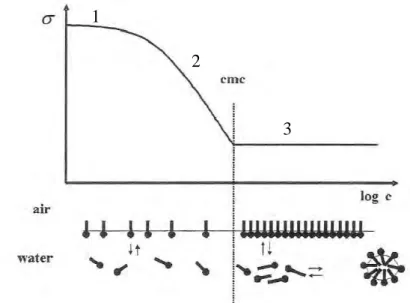
![Fig. 2.9. The general form of the Krafft boundary. [28]](https://thumb-eu.123doks.com/thumbv2/1library_info/3669060.1504191/24.892.243.626.104.374/fig-general-form-krafft-boundary.webp)
![Table 2.1. Methods for measuring surface and interfacial tension of liquid interfaces [30]](https://thumb-eu.123doks.com/thumbv2/1library_info/3669060.1504191/25.892.119.785.838.1157/table-methods-measuring-surface-interfacial-tension-liquid-interfaces.webp)
